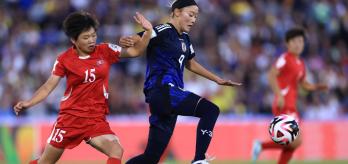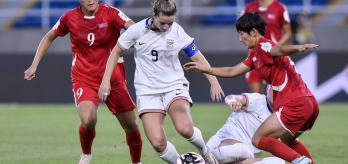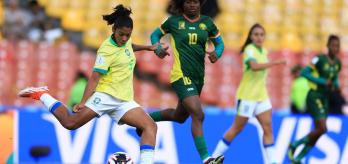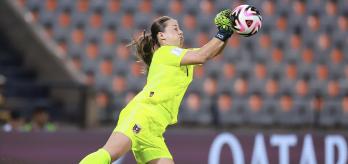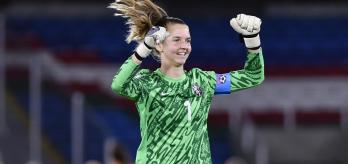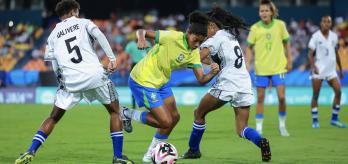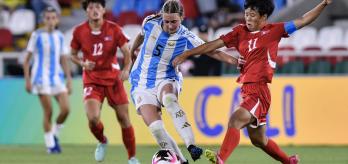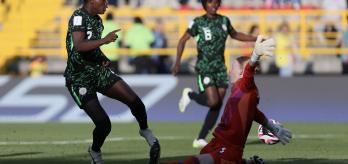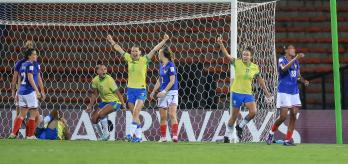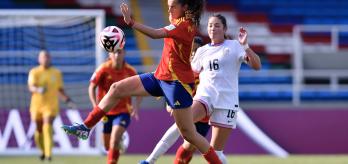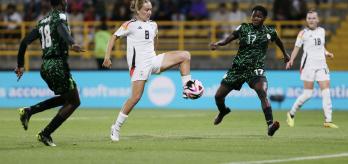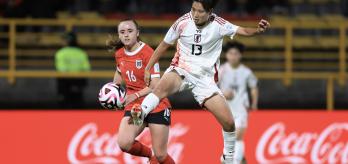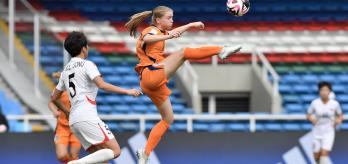Attitude, personality and presence shine through in challenging situations and these are some of the standout qualities that our Technical Study Group have identified in many of the young goalkeepers performing at FIFA U-20 Women’s World Cup Colombia 2024 when dealing with difficult high and low balls into the penalty area.
As Pascal Zuberbühler explains, “The courage, character and sheer determination displayed by so many goalkeepers in these situations has been very impressive. So many goalkeepers are brave in their decisions to defend their zones by coming for balls in the air and on the ground, reading the situations exceptionally well. Their starting positions, judgements and timing have been outstanding, and they are so determined to come for those balls and make the interventions. Clearly, they are training for these situations with their teams because often the defenders are not surprised when they come out to attack the ball, so there is clear understanding between them.”
With the quarter-final stage of the tournament in Colombia now complete, our Football Performance Insights Team have noted that at this stage, it appears that goalkeepers are performing more defensive actions inside the penalty area (per 60 minutes effective playing time) in 2024 with an average of 28, compared to the average of 23.5 in FIFA U-20 Women's World Cup Costa Rica 2022.
In addition, goalkeepers' active engagements under pressure have also increased from 3.7 in 2022 to 5.0 in 2024 (per 60 minutes effective playing time), while the number of goalkeeper interventions is up from 1.3 to 2.4 (using the same metric).
For Zuberbühler, this is an interesting dynamic.
“I am so pleased to see this standard of goalkeeping in 2024. Really, I have been so impressed. Goalkeepers are higher in confidence and are so proactive in how they are dealing with situations, and these numbers tell us that they are getting more involved. There are so many great examples but below, we have chosen just a few to give insights into some of the great goalkeeping interventions we have seen so far,” he added.
Defending the space
When defending high and low balls, the goalkeeper must have a good overview of the situation and a clear reading of the trajectory of the ball as it travels. However, these skills mean nothing if she does not have the resolute determination to come and attack the ball, ensuring she makes contact ahead of other players. Timing, courage and explosivity in those first steps towards the ball are of paramount importance if the goalkeeper is to be successful in these situations.
In addition, goalkeepers must be aware of the positioning of their defenders and must understand the areas they should defend. It is also important for the defenders to understand the strengths of their goalkeeper and their expected behaviour in these situations. They must know that if their goalkeeper comes out to intervene, that they will commit 100% to the duel for first contact.
High balls
Zuberbühler has selected four clips to highlight some of the decision-making and personality qualities that have been displayed by goalkeepers when coming to defend against high balls.
“In clip 1, against Australia, we see a proactive decision from Mexico goalkeeper, Renatta Cota (1), from a set play situation. It is clear that she must defend her zone but what is important in this situation is how she waits when the ball is in the air before judging and deciding on the moment to come and attack the ball. Once she makes the decision, she comes forward with determination to ensure she gets contact with the ball ahead of other players. She is brave, clear with her intentions and gets a strong punch to clear the ball from danger.
“In clip 2, also from a set play situation, we see a great intervention from Colombia goalkeeper, Luisa Agudelo (1). For a 17-year-old, it is outstanding how many times she has made interventions like this, and here we have just one of a number of clips that we could have shown. Firstly, her starting position already shows her intent and secondly, when the ball is struck, she waits until it passes over her first defender (Linda Caicedo) before advancing. Once she decides when to come, she does so without hesitation and takes explosive steps forward. No one will get in her way, and she even collides with one of her own defenders as she makes a powerful contact with the ball. Her attitude, willingness and determination in this situation are so impressive.
“Clip 3 is an example from the Netherlands’ goalkeeper, Femke Liefting (1), who bravely comes to punch the ball away, undeterred by the potential of colliding with other players. With her height and power, she takes a slightly advanced position but as we can see, she has no protection in this situation. Her bravery and attitude to come out with two fists are impressive because she cannot protect herself and collides heavily with Colombia centre-back, Yunaira López (4), who is also attacking the ball with intent. She makes a great and important intervention.
“The final example is clip 4 where Hyon Son-Gyong (1) claims a difficult ball in their game against the Netherlands. This cross is a tricky one because it is not very high, so the goalkeeper must be ready in situations like this. Her starting position is very good as well as her decision to come for this ball. She takes a short first step before advancing at speed and this this helps with her timing to claim the ball with strong hands ahead of the opposition’s attacking player. This is a strong and determined piece of goalkeeping.”
Low balls into the penalty area
Many of the principles that apply to dealing with high, aerial balls also apply to low-ball situations. In the selected clips below, Zuberbühler details some high-quality interventions made by goalkeepers when defending the space against low balls.
“In clip 5 we see a situation in the 88th minute of Morocco’s game against the USA. Goalkeeper Fatima El Jebraoui (12) takes a starting position almost on her six-yard line and has everything under control. Her anticipation here is crucial because she sees that the through pass is coming to her left side and reads the situation perfectly. She makes the decision to come for the ball and fully commits to the action. She must be brave because this is a clear 50/50 ball, and she shows great determination when diving for it using both hands. As she approaches the ball, her own recovering defender pulls back to ensure she had the space to make the intervention and trusted her to do it. She was saying, ‘that’s my ball’, and took it. It is also interesting that she has faced four 1v1 situations in the tournament so far and has successfully intervened in all four,” Zubi explained.
“Clip 6 shows a great example of one of the many 1v1 situations that the Netherlands goalkeeper, Femke Liefting (1), had to deal with. She is very strong in these situations and her anticipation is excellent. Her starting position is on the six-yard line, and she has a clear view to attack Caicedo's through ball. Liefting makes her decision early and sprints forward in a straight line with no hesitation, showing real determination to command the situation. It is a risky action because if she mistimes it, she will likely concede a penalty, so she shows courage and confidence by coming and collecting this ball ahead of Karla Torres (15), the onrushing Colombian forward player.
“In clip 7, we have a slightly different situation where Ghana forward, Stella Nyamekye (10), has the ball at her feet before taking a long touch. Japan goalkeeper, Akane Ōkuma (1), does very well here because she starts at her first post, recognising that the player with the ball has the advantage in this situation. However, as soon as Nyamekye plays the ball a little too far ahead, Ōkuma immediately recognises her opportunity to intervene, taking six explosive steps forward before claiming the ball low at Nyamekye’s feet. These instincts and judgements as a goalkeeper are so important because the player with the ball has the advantage and you must wait for the right moment.
“And finally, in clip 8, Korea Republic goalkeeper, Woo Seo-Bin (1) makes a great intervention in a very dangerous 1v1 situation against Colombia. As Caicedo (18) plays the through ball forward, Woo takes a step backwards before recognising that her defenders have been bypassed and she now must make the intervention. She is quite late coming and doesn’t jump in straight away. She is clever and waits before doing everything possible to deflect the ball. In a situation like this, the goalkeeper must time everything precisely because a mistimed intervention will result in a penalty. However, here, she advances, waits and times it perfectly to reach the ball with her hands. It’s a super intervention,” according to Zuberbühler.
Summary
Goalkeepers are performing more defensive actions in their penalty areas during the FIFA U-20 Women’s World Cup Colombia 2024 in comparison to the previous tournament in 2022. They are also involved in more active engagements under pressure, and they are making more interventions.
There are similar principles that apply when dealing with high and low balls into the penalty area, including reading the situation in relation to the positioning of your defenders and judging the trajectory of the ball. Having the technical skills and physical attributes are crucial in these situations to ensure good starting positions, decision-making, timing and explosivity. However, having courage, confidence and determination in these moments is vital, as is the understanding with defenders that once the goalkeeper makes the decision to come for a ball, that they will commit to it 100%.






